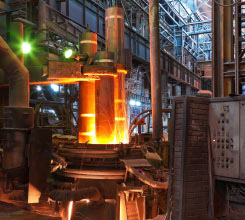The world of the
REMONDIS Lippe Plant
Specific types of metals and alloys are needed to manufacture high quality – and especially dishwasher-safe – cutlery. But where can we get these metals from if we don’t want to steal Nature’s supplies? One example: from new scrap from stainless steel production processes.

Input material
Recovery
We not only recover large quantities of metal at our facilities, we also achieve the highest levels of purity.

Recycling process
International imports have prompted both the European and German high grade steel markets to focus on producing special quality steels with particularly high quality alloying elements. This means that valuable components – such as nickel, chromium and molybdenum – are being added to the steel. These, however, are not only in the final product but also in the production residue: in the metal slag and spent refractories. It is, therefore, well worth its while to recycle these two material streams to recover these valuable raw materials so that they can be returned and reused by the high grade steel and copper industry. Located at the Lippe Plant, this is exactly what REMONDIS Production’s LEGRAN business division does.

REMONDIS Production’s facility at the Lippe Plant primarily processes slag from electric arc furnaces – these are used to produce particularly high quality steel
The production of high grade steel begins in electric arc furnaces. These use electrical energy to melt down metal scrap and alloying elements. The whole process takes place using electrodes which are lowered into the material and create temperatures of up to 3,500°C. During the next step (the secondary metallurgy process), alloying elements are added to the liquid metal to meet the exact specifications required for the various areas of use. A homogenous layer of slag forms on the surface of the hot, liquid high grade steel during the production process. This is removed from the liquid high grade steel at the end of the production process and stored separately.

The metal slag, which floats on the surface of the liquid high grade steel, is separated from the liquid metal, removed from the furnace and stored
Both the high temperatures and the thermal process result in residual materials sticking to and drying on the surface of the furnace. The refractory material must, therefore, be replaced at regular intervals to prevent the furnace being permanently damaged. The material – known as spent refractory – is effectively broken off the furnace walls. It contains large amounts of mineral residue as well as traces of the alloying elements used to produce the high grade steel.

LEGRAN’s recycling process produces high purity granules – for example made of copper.
Practically all of the metals contained in the slag can be recovered. Go to recycling process
The special feature of LEGRAN’s metal slag processing system is the way the material is treated. The slag and spent refractories need to be pulverised before they can be processed and this job is carried out by a rod and ball mill which dates back to the time when the site used to produce aluminium. The quality and level of purity of the recovered metals are second to none thanks to the combined use of this system and the subsequent separation methods. This intelligent reuse of the site’s existing technology, therefore, not only benefits REMONDIS but its customers as well. What’s more – thanks to the company’s years of know-how and the ongoing improvements that have made to the technology used – customer-specific and material-specific solutions can be offered whenever they’re needed.

Metal trapped in the slag
Recycling metal slag is also good for the environment. Processing this material creates both environmental and economic advantages as it prevents the rare and valuable alloying elements from being wasted. Leading high grade steel producers across Europe now use LEGRAN’s services thanks to the developments it has made to its technology and the huge capacities of its plant. What’s more, they no longer have to handle the process of sending their residue to landfill. Indeed, customers have been impressed by the innovative ideas REMONDIS has introduced at the Lippe Plant regarding the whole issue of landfilling. Technology, for example, has been developed that removes practically all of the water from the remaining finely powdered mineral so that less landfill space is needed. The ultimate goal, though, is to stop sending material to landfill at all. At the moment, every effort is being made to find ways to process this material so it can be reused by the industrial sector.
One of the highlights of LEGRAN’s metal processing system at the Lippe Plant is the way the process water is sourced and treated. The plant uses the rainwater that falls on the landfill. This rainwater collects in the leachate treatment facility where any pollutants are removed. Once cleaned, the water is used in the mills for grinding the slag and spent refractories before being pumped back to the leachate facility after the dewatering stage so that it can be cleaned again. A closed water cycle in other words. Any excess water is pre-treated and neutralised and then transferred to the Emscher wastewater treatment facility.


31,000t is the same amount of carbon emitted by a car travelling around the world five times
LEGRAN’s metal slag processing not only benefits steelworks and other metal processors, it also protects the environment. In other words: it is vital as it helps curb climate change. Every gram of metal that is recovered and returned to production cycles reduces energy consumption and environmental pollution. How? The alternative – i.e. using ore to produce metals – is extremely energy-intensive and generates large volumes of carbon emissions. To say nothing of the negative impact that the mining and transport of the natural resources have on the environment.

Diese Seite verwendet aktuelle Techniken, die in dem von Ihnen verwendeten Browser unter Umständen nicht korrekt
angezeigt werden können.
Bitte aktualisieren Sie Ihren Internet-Explorer oder weichen auf einen anderen Browser wie Chrome oder
Firefox aus.
Schließen